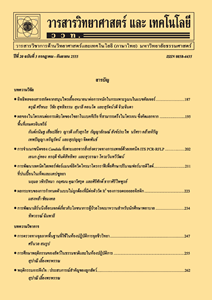การพัฒนาเครื่องกำเนิดไฟฟ้ากระแสตรงโดยอาศัยพลังงานจากแรงกดของรถยนต์
Main Article Content
Abstract
This article presents the development and efficiency evaluation of the direct current generator using energy form automobile pressure. The purposes of this study are to create a direct current generator and to evaluate efficiency of the direct current generator that can produce electricity. The mechanical structure was made of rectangular steel with the size of 1.5 x 1.5 inches, two pieces of rubber speed bump with the size of 35 x 105 x 45 cm (width x length x height), Panasonic Motor Generator Model 022P1S, crank shaft, restoring force type of spring, bearing, and leather belt. The control circuit using Arduino Pro mini is utilized coordinately with a created circuit board. The results showed that for persistence performance, after testing with the weight of vehicle, there was no effect on the mechanical structure. For power productivity performance, it was found that the produced power outputs of the front and rear wheels were averages of 1.22 and 1.59 Watts, respectively. For the battery voltage retention performance, it was found that an input voltage level was 48.86 Volts. In addition, for the performance of the display of the charging control circuit, it was found that the presentation of display had the error of 0.04 Volts of battery voltage and 0.02 Amperes of a current from the battery. These could confirm the efficiency of the created generator from the test of actual using.
Article Details
References
[2] Ministry of Energy, Energy Situation and Energy Consumption for the Environment, Chiang Mai University, Chiang Mai. (in Thai)
[3] Ministry of Science and Technology, National Innovation Agency, 2555, Pilot Project for the Production of Renewable Energy from Biomass at the Community Level, Available Source: http://www.nia.or.th/nia/strategy/innovation-project/strategy/clean-energy, February 20, 2017. (in Thai)
[4] Thipwong, S., 2013, Wind Turbine for Exterior Lighting, Master Thesis, Phetchabun Rajabhat University, Phetchabun. (in Thai)
[5] The Secretariat of the House of Representatives, Clean energy, New Options for Thai people, Available Source: http://www.pacproshop.com/energy/1354, November 4, 2016. (in Thai)
[6] Sengphat, K., 2007, The Development of Efficiency Direct Current Generator from Power Presser from Car, Master Thesis, King Mongkut's University of Technology Thonburi, Bangkok. (in Thai)
[7] Kulprasut, P., 2008, Power Transmission and Automatic Transmission Shaft Set, Chulalongkorn University, Bangkok. (in Thai)
[8] Panphibun, P. and Saengban, V., 2007, The Development of Battery Electric Charge System with Alternator by Mechanical Energy from Bicycle Spin, Master Thesis, Rajabhat Mahasarakham University, Mahasarakham. (in Thai)
[9] Gnem Rvc, Calculation Method - Maximum Weight Support - Selection of Dimensions of Steel Columns, Available Source: https://www.scribd.com/docu ment/361575773/19-850f9d32a987725d3 533d3bfd7031e9a-pdf, December 1, 2017. (in Thai)
[10] Wongkaew, A. and Leelataviwat, S., Chapter 3: Steel Structure Design, Available Source: http://www.coe.or.th/coe -2/Download/Articles/CE/CH3.pdf, December 1, 2017. (in Thai)
[11] Khan Academy, What is Hooke’s Law, Available Source: https://www.khanacademy.org/science/physics/work-and-energy/hookes-law/a/what-is-hookes-law, July 21, 2018.
[12] Bangsiri, A., 2013, AutoCAD 2013 for Beginners, Simplify, Bangkok. (in Thai)


